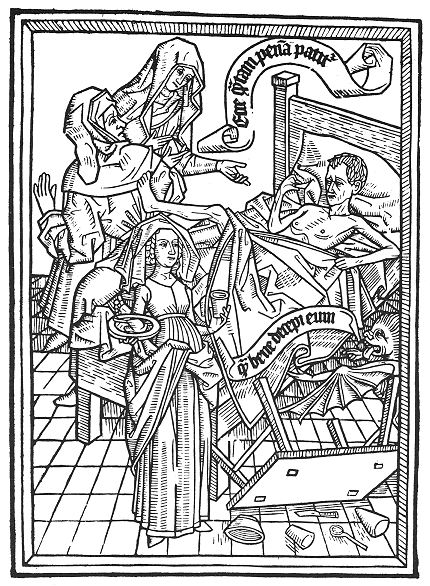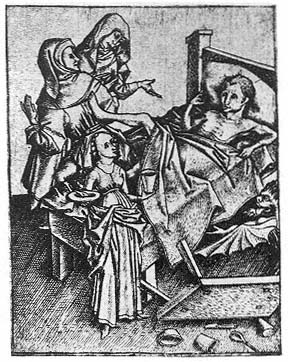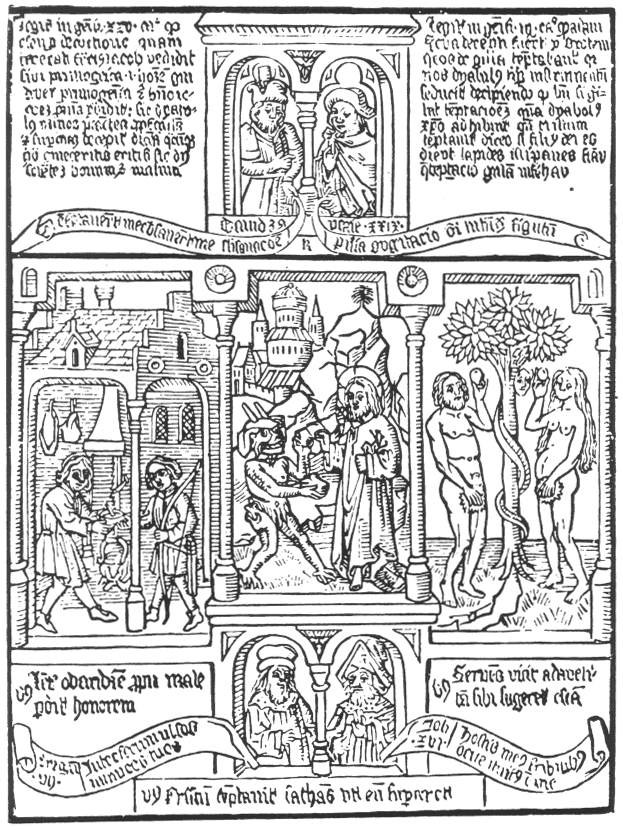Ars Moriendi
The first edition of the xylographic Ars moriendi is acknowledged by some art historians as the great masterpiece of the Netherlandish blockbooks. It was extremely popular (some twenty editions are known), no doubt because of the pervasive fear of death from the plagues and pestilences which ravaged Europe from 1347 until the seventeenth century. The book appeared later in many editions with typographically printed text, some using copies of the original woodcuts. Priests, called constantly to the bedsides of the moribund, used the pictures and texts to help prepare the pious for the hereafter.
The Weigel copy of the blockbook in the British Library is probably the oldest, produced about 1450 (fig. IV-6). It is in Latin, but subsequent editions are known in French, Dutch, and German. Thirteen groups of blocks with text banderoles were used in the twenty blockbook editions.[13] They were printed on one side of the paper facing a page of xylographic text. In the first ten scenes the pictures show the devil and his demons trying to seize the soul of the dying man through temptations, and the attendants giving good counsel at the deathbed. The eleventh picture is of the triumph over all temptations in the hour of death. The text, thought to have been inspired by the writings of Jean Gerson (1363–1429),[14] was intended to serve as a manual for clerics.
The Ars moriendi occupies a special place in the history of woodcuts and of the blockbooks. Unlike most of the others it is not concerned with typology or Old Testament prophecy, or with the Gospels. The artist drew the subjects and compositions from a series of eleven small engravings of about 1440 by the Master E.S., the only complete set of which is in the Ashmolean Museum at Oxford (fig. IV-7). The vigor and refinement of the blockbook pictures surpass the level of the engravings of the Master E. S.; faulty perspective is corrected and text banderoles are added.[15] It has been suggested that these fine blocks should be attributed to the immediate entourage of Roger van der Weyden, although, among the thirteen groups of illustrations, several different styles may be found.
[13] Schreiber, op.cit. , IV, p. 257.
[14] Delen, op.cit. , p. 61.
[15] Lionel Cust, The Master E. S. and the 'Ars Moriendi ' (Oxford, 1898).

IV-6.
Xylographic first edition.
Impatience.
Ars moriendi blockbook, Schreiber Ia.

IV-7.
Line-engraving by the Master E.S.
Impatience.
Ars moriendi .

IV-8.
The Temptation of Esau.
The Temptation of Christ.
The Temptation of Adam and Eve.
Biblia pauperum blockbook, Schreiber III.